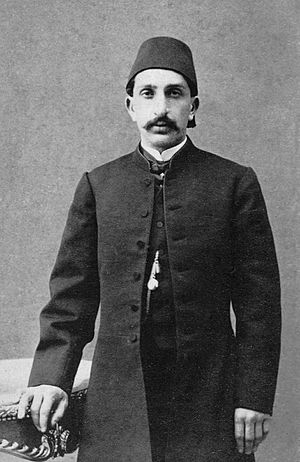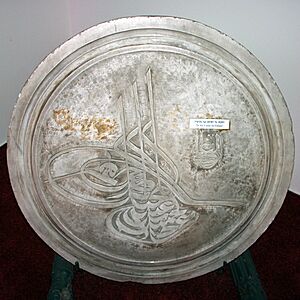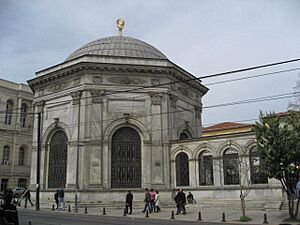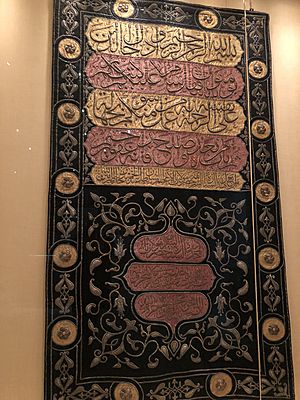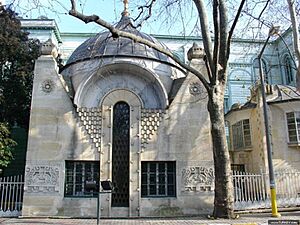Abdul Hamid II facts for kids
Quick facts for kids Abdul Hamid II |
|||||
|---|---|---|---|---|---|
| Ottoman Caliph Amir al-Mu'minin Custodian of the Two Holy Mosques |
|||||

Portrait of Sultan Abdul Hamid II in 1899
|
|||||
| Sultan of the Ottoman Empire (Padishah) | |||||
| Reign | 31 August 1876 – 27 April 1909 | ||||
| Sword girding | 7 September 1876 | ||||
| Predecessor | Murad V | ||||
| Successor | Mehmed V | ||||
| Grand Viziers |
See list
Mehmed Rushdi Pasha
Midhat Pasha Ibrahim Edhem Pasha Ahmed Hamdi Pasha Ahmed Vefik Pasha Mehmed Sadık Pasha Saffet Pasha Tunuslu Hayreddin Pasha Ahmed Arifi Pasha Mehmed Said Pasha Kadri Pasha Abdurrahman Nurettin Pasha Kâmil Pasha Ahmed Cevad Pasha Halil Rifat Pasha Mehmed Ferid Pasha Hüseyin Hilmi Pasha Ahmet Tevfik Pasha |
||||
| Born | 21 September 1842 Topkapı Palace, Constantinople, Ottoman Empire |
||||
| Died | 10 February 1918 (aged 75) Beylerbeyi Palace, Constantinople, Ottoman Empire |
||||
| Burial | 1918 Tomb of Sultan Mahmud II, Fatih, Istanbul, Turkey |
||||
| Consorts |
List
Nazikeda Kadın
Safinaz Nurefsun Kadın Bedrifelek Kadın Bidar Kadın Dilpesend Kadın Mezidemestan Kadın Emsalinur Kadın Destizer Müşfika Kadın Sazkar Hanım Rabia Peyveste Hanım Fatma Pesend Hanım Behice Hanım Saliha Naciye Kadın |
||||
| Issue Among others |
List
|
||||
|
|||||
| Dynasty | Ottoman | ||||
| Father | Abdulmejid I | ||||
| Mother | Biological mother: Tirimüjgan Kadın Adoptive mother: Rahime Perestu Sultan |
||||
| Religion | Sunni Islam | ||||
| Tughra |  |
||||
Abdülhamid II (born 21 September 1842, died 10 February 1918) was the sultan of the Ottoman Empire from 1876 to 1909. He was the last sultan to have strong control over the empire. His time as ruler is known as the Hamidian Era.
During his reign, the Ottoman Empire faced many challenges. There were rebellions, especially in the Balkans. He also led the empire through a difficult war with Russia (1877–1878). Later, the Ottomans won a war against the Kingdom of Greece in 1897. But European countries often stepped in, which limited the Ottoman Empire's gains.
Early in his rule, Abdul Hamid II agreed to a new constitution. This showed a modern way of thinking. However, in 1878, he stopped the constitution and closed the parliament. He said there were disagreements. Yet, the Ottoman Empire continued to modernize. New railways were built, like the Baghdad Railway and the Hejaz Railway. Systems for keeping track of the population and controlling the press were also set up. Many professional schools were opened for law, arts, and engineering. Istanbul University was reopened in 1900. German companies helped a lot with building railways and telegraph lines. But this modernization also meant that other powerful countries gained control over the empire's money.
Abdul Hamid's reign also saw difficult times for some groups, like the Armenians. There were also several attempts to assassinate him. One famous attempt was in 1905 by the Armenian Revolutionary Federation. Many educated people criticized him for using secret police to stop people from speaking out. The Young Turks movement grew against him. In 1908, the Young Turks forced him to bring back the parliament and the constitution. A year later, Abdul Hamid tried to regain full power. This led to him being removed from the throne in 1909 by the Unionist forces.
Early Life of Abdul Hamid II

Abdul Hamid II was born on 21 September 1842 in Istanbul. His father was Sultan Abdulmejid I. His mother was Tirimüjgan Kadın. After his mother passed away, he was adopted by his father's wife, Perestu Kadın. She also adopted his half-sister, Cemile Sultan. They grew up together in the same home.
Unlike many other Ottoman sultans, Abdul Hamid II traveled to faraway countries. Nine years before he became sultan, he visited Europe. He went with his uncle, Sultan Abdülaziz, to cities like Paris, London, and Vienna in 1867.
Becoming Sultan
Abdul Hamid became sultan on 31 August 1876. This happened after his brother, Murad V, was removed from the throne. Many people thought Abdul Hamid II would support modern ideas. However, he became sultan during a very tough time for the empire. There were money problems, political unrest, and wars in the Balkans. The Russo-Turkish War (1877–1878) also threatened the empire. Abdul Hamid used these difficult times to take back full control. He closed the parliament and held all political power until he was overthrown.
First Constitution (1876–1878)
Abdul Hamid worked with a group called the Young Ottomans. They wanted to create a new constitution. They believed a modern parliament would follow Islamic ideas of consultation.
In December 1876, Abdul Hamid announced the first constitution and parliament. This happened because of rebellions in Bosnia and Herzegovina. There were also wars with Serbia and Montenegro. And European countries were upset about how the 1876 Bulgarian rebellion was handled. The new constitution gave Abdul Hamid the right to remove anyone he saw as a threat. It also set up a two-house parliament.
European countries at the Constantinople Conference in 1876 were surprised by the constitution. But they didn't think it was a big enough change. They questioned if a parliament was really needed.
Soon after, in early 1877, the Ottoman Empire went to war with Russia.
War with Russia (1877–1878)
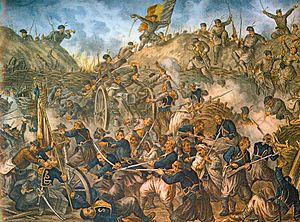
Abdul Hamid's biggest fear, the empire falling apart, almost came true. Russia declared war on 24 April 1877. The Ottoman Empire fought alone. Other European countries did not help. Britain did not get involved because people were upset about Ottoman actions in Bulgaria. Russia won the war quickly. It ended in February 1878.
The Treaty of San Stefano was signed. It set harsh terms for the Ottomans. Romania, Serbia, and Montenegro became independent. Bulgaria gained self-rule. Bosnia and Herzegovina had to make reforms. Parts of Dobrudzha and Armenia were given to Russia. The Ottomans also had to pay a lot of money. After the war, Abdul Hamid stopped the constitution in February 1878. He closed the parliament after only one meeting. For the next 30 years, Abdul Hamid ruled the empire from Yıldız Palace.
Russia's power in Southeast Europe grew a lot after the treaty. But other powerful countries, especially Britain, made changes to the treaty at the Congress of Berlin. This reduced Russia's gains. In return, Cyprus was given to Britain in 1878. There were also problems in Egypt. Britain sent troops in 1882 and gained control over Egypt and Sudan. These areas officially remained Ottoman until 1914. Then Britain took them over when the Ottomans joined World War I.
Hamidian Era
Challenges to the Empire
Abdul Hamid did not trust the navy's admirals. He thought they were plotting against him. He suspected they wanted to bring back the 1876 constitution. So, he ordered the Ottoman fleet to stay inside the Golden Horn. This was a problem because the Ottoman navy was once the third largest in the world. This decision led to the loss of Ottoman lands and islands in North Africa, the Mediterranean, and the Aegean Sea.
The empire also had money problems. Abdul Hamid had to let foreign countries control the Ottoman national debt. In 1881, a large part of the empire's income went to the Ottoman Public Debt Administration. This money was for foreign bondholders.
Another blow was when Bulgaria united with Eastern Rumelia in 1885. A strong, independent Bulgaria was a big threat to the Ottoman Empire. Abdul Hamid had to deal with Bulgaria carefully. He did not want to upset Russia or Germany. There were also issues with Albania, Greece, and Montenegro. European powers wanted the decisions from the Congress of Berlin to be followed.
Crete was given special rights. But the people there wanted to unite with Greece. In 1897, a Greek group went to Crete to overthrow Ottoman rule. This led to a war where the Ottoman Empire defeated Greece. However, Crete was later taken over by the United Kingdom, France, and Russia. Prince George of Greece was made ruler, and Crete was effectively lost to the Ottoman Empire.
Reforms and Rule
Many people thought Abdul Hamid II would be a liberal ruler. But he became more conservative after taking the throne. He took much of the empire's control into his own hands at Yıldız Palace. He made his ministers more like secretaries. The empire faced many problems when he became sultan. These included money issues, rebellions, and wars. These problems made him hesitant to make big changes.
He focused on education. He opened 18 professional schools. In 1900, Istanbul University was established. He also created many secondary, primary, and military schools across the empire. These schools used European teaching methods. But they also taught students about Ottoman identity and Islamic values.
Abdul Hamid also reorganized the Ministry of Justice. He developed railway and telegraph systems. The telegraph system reached the farthest parts of the empire. Railways connected Constantinople and Vienna by 1883. The Orient Express soon connected Paris to Constantinople. Railways within the empire also grew. This made it easier to travel and communicate. It helped Constantinople have more influence over the empire.
Abdul Hamid was very careful about his safety. He remembered how his uncle, Abdulaziz, was removed from power. This made him believe that a constitutional government was not a good idea. So, he controlled information strictly. The press was heavily censored. A secret police and spies were everywhere. Many politicians were arrested or sent away. School lessons were checked carefully to prevent any disagreement. But, ironically, the schools he founded sometimes became places where people felt unhappy with the strict rules.
Armenian Question

Around 1890, Armenians started asking for reforms. These reforms had been promised to them at the Congress of Berlin. To stop these changes, Sultan Abdul Hamid gave special status to Kurdish groups. These groups were already causing trouble for Armenians. They were called the Hamidiye Regiments. They were allowed to attack Armenians and take their food and animals. They knew they would not be punished.
Because of this violence, Armenians formed revolutionary groups. Clashes and unrest happened in 1892 and 1893. Abdul Hamid II used harsh methods to stop these revolts. He used local Muslims against the Armenians. This period saw many Armenians killed. News of these events spread in Europe and the United States. Foreign governments and aid groups reacted strongly. Abdul Hamid II became known as the "Bloody Sultan" or "Red Sultan" in the West.
On 21 July 1905, the Armenian Revolutionary Federation tried to assassinate him. They used a car bomb during a public event. But the Sultan was delayed for a minute, and the bomb exploded too early. It killed 26 people and injured 58. This continued violence and how he handled Armenian requests for reforms made Western European powers more involved.
Relations with America and the Philippines
Sultan Abdul Hamid II was asked by the American minister to Turkey, Oscar Straus, for help. This was at the start of the Moro Rebellion in the Philippines. The Sultan sent a letter to the Moros of the Sulu Sultanate. He told them not to fight the Americans and to work with them. The Sulu Moros followed this order.
The American Secretary of State, John Hay, asked Straus in 1898 to get the Sultan's help. The Sultan was also the Caliph, a religious leader. He wrote a letter to the Moro Sulu Muslims in the Philippines. He told them to accept American rule. This letter was successful. The "Sulu Mohammedans... refused to join the rebels and placed themselves under our army." The Ottoman Sultan used his religious authority to tell the Sulu Sultan not to fight the Americans.
However, the Bates Treaty, which guaranteed the Sulu Sultanate's self-rule, was later broken by the Americans. This led to the Moro Rebellion in 1904. There was fighting between Americans and Moro Muslims.
Germany's Support
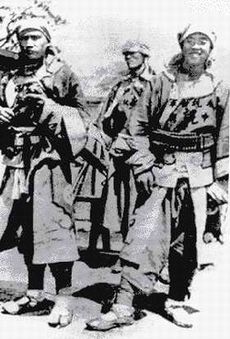
The United Kingdom, France, and Russia had difficult relations with the Ottoman Empire. Abdul Hamid and his advisors believed the empire should be treated equally by these big powers. The Sultan saw the Ottoman Empire as a European empire, but with more Muslims than Christians.
Over time, France took over Tunisia in 1881. Britain gained control in Egypt in 1882. These actions made Abdul Hamid turn towards Germany. Kaiser Wilhelm II visited Abdul Hamid in Istanbul twice. German officers helped organize the Ottoman army.
German government officials also helped reorganize the Ottoman government's money. Germany's friendship was not free. It came with railway and loan deals. In 1899, Germany was allowed to build the Berlin-Baghdad railway.
Kaiser Wilhelm II also asked the Sultan for help with Chinese Muslim troops. During the Boxer Rebellion, Chinese Muslim soldiers fought against the German Army. They defeated the Alliance forces. Kaiser Wilhelm was worried by these troops. He asked Abdul Hamid to find a way to stop them from fighting. Abdul Hamid agreed and sent someone to China in 1901. But the rebellion was over by then. The Ottomans did not want conflict with European nations. They also wanted Germany's help. So, the Ottoman Caliph issued an order telling Chinese Muslims not to help the Boxers. This order was printed in Egyptian and Indian Muslim newspapers.
Young Turk Revolution
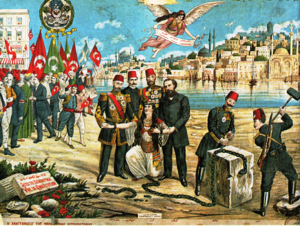
The problems in Macedonia and anger in the army against palace spies led to a crisis. The Committee of Union and Progress (CUP), a Young Turks group, started the Young Turk Revolution in 1908. Abdul Hamid learned that troops were marching on Istanbul. He quickly gave in. On 24 July, he announced that the 1876 constitution would be brought back. The next day, he ended spying and censorship. He also ordered the release of political prisoners.
On 17 December, Abdul Hamid opened the Ottoman parliament. He said that the first parliament had been "temporarily dissolved" until people were educated enough.
Removal from Power
The Sultan's new attitude did not stop people from suspecting him. They thought he was working with conservative groups in the state. This was confirmed by his actions during the counter-revolution on 13 April 1909. This event is known as the 31 March Incident. Soldiers, supported by some military conservatives, overthrew the government. Abdul Hamid appointed a new leader and again stopped the constitution and closed parliament.
However, the Sultan only controlled Constantinople. The Young Turks still had influence in the rest of the army and provinces. The CUP asked Mahmud Shevket Pasha to fix the situation. He formed an army called the Action Army. This army marched on Constantinople. It was secretly decided that Abdul Hamid had to be removed. When the Action Army entered Istanbul, a religious ruling was issued against Abdul Hamid. The parliament voted to remove him from the throne. On 27 April, Abdul Hamid's half-brother, Reshad Efendi, became Sultan Mehmed V.
The Sultan's attempt to regain power led to violence against Christian Armenians in the Adana province. This is known as the Adana massacre.
After Being Removed
The former sultan was taken to Thessaloniki as a prisoner. In 1912, when Thessaloniki fell to Greece, he was brought back to Constantinople. He spent his last days studying, doing carpentry, and writing his memories. He was held at Beylerbeyi Palace with his wives and children. He passed away there on 10 February 1918. This was just a few months before his brother, Mehmed V, died. He was buried in Istanbul.
In 1930, his family was given money from his estate. His estate was worth a lot of money.
Abdul Hamid was the last Ottoman Sultan to have absolute power. He ruled for 33 years during a time when the empire was seen as the "sick man of Europe" by other countries.
Pan-Islamism
Abdul Hamid believed that earlier reforms could not unite the different people of the empire. So, he adopted a new idea called Pan-Islamism. Ottoman sultans had also been Caliphs since 1517. He wanted to highlight this fact and promote the Ottoman Caliphate. He saw the many different groups in the Ottoman Empire. He believed that Islam was the only way to unite his Muslim people.
He encouraged Pan-Islamism. He told Muslims living under European powers to unite. This worried several European countries. These included Austria, Russia, France, Spain, and Britain. He also limited the special rights of foreigners in the Ottoman Empire. At the very end of his reign, he provided money to start building the important Constantinople-Baghdad Railway and the Constantinople-Medina Railway. This made the trip to Mecca for Hajj easier. After he was removed, the Young Turks sped up the construction of both railways. Missionaries were sent to faraway countries to spread Islam and the Caliph's authority.
During his rule, Abdul Hamid refused offers from Theodor Herzl. Herzl offered to pay a large part of the Ottoman debt. In return, he wanted permission for Zionists to settle in Palestine. Abdul Hamid famously said that as long as he was alive, he would not let their land be divided.
Pan-Islamism was quite successful. After the Greco-Ottoman war, many Muslims celebrated the Ottoman victory. They saw it as a Muslim victory. There were reports of uprisings and protests against European colonization in Muslim regions after the war. However, Abdul Hamid's appeals to Muslim feelings were not always effective. There was still much unhappiness within the empire. In Mesopotamia and Yemen, there were constant disturbances. Closer to home, loyalty was kept in the army and among Muslims only through a system of control and spying.
Personal Life
Abdul Hamid II was a skilled carpenter. He made some high-quality furniture himself. You can see it today at the Yıldız Palace, Şale Köşkü, and Beylerbeyi Palace in Istanbul. He also loved opera. He personally translated many famous operas into Ottoman Turkish. He even wrote some opera pieces for the Ottoman Imperial Band. He hosted famous European performers at the Opera House of Yıldız Palace. One of his guests was the famous French actress Sarah Bernhardt.
He was also a good wrestler of Yağlı güreş (oil wrestling). He supported wrestlers and organized tournaments. He would invite good wrestlers to the palace. He was also a skilled artist. He drew the only known portrait of his fourth wife, Bidar Kadın. He really enjoyed Sherlock Holmes novels. He gave the author, Sir Arthur Conan Doyle, an award in 1907.
Religion
Sultan Abdul Hamid II practiced traditional Islamic Sufism. He was influenced by a Libyan Sufi Sheikh named Muhammad Zafir al-Madani. Abdul Hamid II asked Sheikh al-Madani to come to Istanbul after he became Sultan. The sheikh held Sufi gatherings at the Yıldız Hamidiye Mosque. Abdul Hamid II would join Sufi masters in reciting dhikr (remembrance) on Thursday evenings. The sheikh became a close religious and political advisor to the Sultan. In 1879, the Sultan removed taxes for all Sufi lodges. In 1888, he even built a Sufi lodge for the Madani order in Istanbul. This relationship lasted for 30 years until the sheikh's death in 1903.
Poetry

Abdul Hamid wrote poetry, just like many other Ottoman sultans before him.
Family
Abdülhamid II had many wives. But he did not let any of them have political power. He believed that too much involvement from women in the imperial family had harmed the reigns of his uncle and father. The only partial exception was his half-sister, Cemile Sultan.
Consorts
Abdülhamid II had at least sixteen consorts:
- Nazikeda Kadın (1848 - 1895). She was his First Consort. She had one daughter.
- Safinaz Nurefsun Kadın (1850 - 1915). She married Abdülhamid in 1868. She had no children.
- Bedrifelek Kadın (1851 - 1930). She had two sons and one daughter.
- Bidar Kadın (1855 - 1918). She had one son and one daughter.
- Dilpesend Kadın (1865 - 1901). She had two daughters.
- Mezidemestan Kadın (1869 - 1909). She had one son.
- Emsalinur Kadın (1866 - 1952). She had one daughter.
- Destizer Müşfika Kadın (1872 - 1961). She stayed with Abdülhamid until his death. She had one daughter.
- Sazkar Hanım (1873 - 1945). She had one daughter.
- Peyveste Hanım (1873 - 1943). She had one son.
- Pesend Hanım (1876 - 1924). She had one daughter.
- Behice Hanım (1882 - 1969). She had two twin sons.
- Saliha Naciye Kadın (1887 - 1923). She had one son and one daughter.
- Dürdane Hanım (1867 - 1957).
- Calibös Hanım (1880 - ?).
- Nazlıyar Hanım.
Sons
Abdülhamid II had at least eight sons:
- Şehzade Mehmed Selim (1870 - 1937) - with Bedrifelek Kadın.
- Şehzade Mehmed Abdülkadir (1878 - 1944) - with Bidar Kadın.
- Şehzade Ahmed Nuri (1878 - 1944) - with Bedrifelek Kadın.
- Şehzade Mehmed Burhaneddin (1885 - 1949) - with Mezidemestan Kadın.
- Şehzade Abdürrahim Hayri (1894 - 1952) - with Peyveste Hanım.
- Şehzade Ahmed Nureddin (1901 - 1944) - with Behice Hanım. He was a twin.
- Şehzade Mehmed Bedreddin (1901 - 1903) - with Behice Hanım. He was a twin and died young.
- Şehzade Mehmed Abid (1905 - 1973) - with Saliha Naciye Kadın.
Daughters
Abdülhamid II had at least thirteen daughters:
- Ulviye Sultan (1868 - 1875) - with Nazikeda Kadın. She died young.
- Zekiye Sultan (1872 - 1950) - with Bedrifelek Kadın. She was one of Abdülhamid's favorite daughters.
- Fatma Naime Sultan (1876 - 1945) - with Bidar Kadın. She was Abdülhamid II's favorite daughter.
- Naile Sultan (1884 - 1957) - with Dilpesend Kadın.
- Seniye Sultan (1884 - 1884) - died young.
- Seniha Sultan (1885 - 1885) - with Dilpesend Kadın. She died young.
- Şadiye Sultan (1886 - 1977) - with Emsalinur Kadın.
- Hamide Ayşe Sultan (1887 - 1960) - with Müşfika Kadın.
- Refia Sultan (1891 - 1938) - with Sazkar Hanım.
- Hatice Sultan (1897 - 1898) - with Pesend Hanım. She died young.
- Aliye Sultan (1900 - 1900) - died young.
- Cemile Sultan (1900 - 1900) - died young.
- Samiye Sultan (1908 - 1909) - with Saliha Naciye Kadın. She died young.
Awards and Honours
- Grand Master of the Order of the Crescent
- Grand Master of the Order of Glory
- Grand Master of the Order of the Medjidie
- Grand Master of the Order of Osmanieh
- Knight Grand Cross of the Order of Saint Stephen of Hungary, in Diamonds (Austria-Hungary)
- Knight of the Order of the Elephant (Kingdom of Denmark)
- Knight of the Order of the Seraphim, in Diamonds (Kingdom of Sweden)
- Knight Grand Cross of the Order of Kamehameha I (Kingdom of Hawaii)
- Knight Grand Cross of the Order of Saint Olav (Kingdom of Norway)
- Knight Grand Cross of the Order of the Tower and Sword (Kingdom of Portugal)
- Knight of the Order of the Golden Fleece (Kingdom of Spain)
- Knight Grand Cross of the Order of the White Falcon (Grand Duchy of Saxe-Weimar-Eisenach)
- Knight Grand Cross with Collar of the Order of Saint Alexander (Principality of Bulgaria)
- Knight Grand Cross with Collar of the Order of Carol I (Kingdom of Romania)
- Knight of the Order of the Annunciation (Kingdom of Italy)
- Knight of the Order of the Black Eagle, in Diamonds (German Empire)
- Knight of the Order of the Royal House of Chakri (Kingdom of Siam)
- Knight Grand Cordon of the Order of the Chrysanthemum (Empire of Japan)
- Knight of the Order of Saint Hubert (Kingdom of Bavaria)
Images for kids
-
Eunuch near the door of the sultan's harem (from East and War by Vlas Doroshevich)
-
Enver Bey, Sultan Abdul Hamid II and Niyazi Bey
-
Abdul Hamid II arrives in Thessaloniki
See Also
 In Spanish: Abdul Hamid II para niños
In Spanish: Abdul Hamid II para niños
- The Ottomans: Europe's Muslim Emperors
- Yıldız Hamidiye Mosque
- List of sultans of the Ottoman Empire
- List of nicknames of European royalty and nobility: A
- Payitaht: Abdülhamid, 2017 TV-drama
- Abdul the Damned


